Battles in chronological order

The Battle of Ashdown - 871
The Battle of Ashdown was fought on 8 January 871. The 21-year-old prince Alfred (later Alfred the Great, led the Saxon army of his elder brother, Ethelred of Wessex to victory in battle against an invading force of Vikings led by Halfdan Ragnarson.
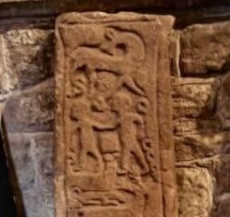
The Battle of Brunanburh - 937
The Battle of Brunanburh, fought in 937 and one of the bloodiest battles ever fought on British soil, was a great Anglo-Saxon victory for a combined Anglo-Saxon army from Mercia and Wessex led by Athelstan, King of England, (the grandson of Alfred the Great) and his brother Edmund over the allied forces of Olaf III Guthfrithson, the Norse-Gael King of Dublin; Constantine II, King of Scots; and Owen I, King of Strathclyde, who invaded England via the Humber.
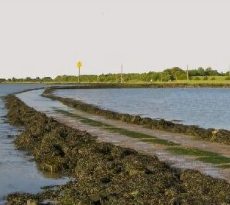
The Battle of Maldon - 991
The Viking attacks on England were ferocious and unremitting. A marauding Viking army under the command of the Norwegian Olaf Tryggvason reached England in 991 and pillaged Folkestone, Sandwich and Ipswich before advancing on Maldon, on the southern shore of the Blackwater Estuary in Essex. They sailed up the River Blackwater (then called the Panta), to Northey Island, a small island in the river.

The Battle of Carham - 1018
Malcolm II, known as 'Forranach' meaning the destoyer, taking advantage of the fact that the English were preoccupied with Viking raids, marched south with Owain the Bald, King of Strathclyde in 1018 or possibly 1016, and together they burnt much of Northumbria. They were met by a local English force led by by Uhtred the Bold, Earl of Northumbria, the son of Waltheof I, ealdorman of Bamburgh, at Carham on Tweed.

The Battle of Stamford Bridge - 1066
There were a number of claimants to England's throne on the death of the childless King Edward The Confessor of England, who was succeeded by his brother-in-law, Harold Godwineson, who was chosen by the Witan, in January of the eventful year of 1066. These claimants included Harald Hardrada, King of Norway, who assembled a fleet of 300 ships, probably carrying about 15,000 troops, to invade England and make good his claim. Hardrada arrived off the English coast in September, where his army was reinforced by Tostig Godwineson, the unruly and discontented brother of Harold, at the head of forces from Flanders and Scotland. Eventually, the Viking army began to fragment and fracture, allowing the English to break in through the shield wall. The fierce fighting continued throughout the afternoon. The massive Viking king Hardrada advanced ahead of his army and in true beserker style, dealt devastating blows to all around him. As dusk drew near, he was killed by an arrow to his windpipe. Tostig took up the fallen Viking Raven Banner, "Land-Ravager" and continued to rallly the troops and fight on but was himself slain.
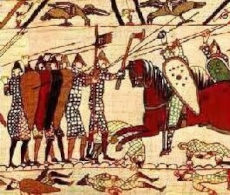
The Battle of Hastings - 1066
The Saxon King, Edward the Confessor, last of the ancient House of Wessex, died childless on the stormy night of 4th -5th January, in the momentous year of 1066. On his deathbed, Edward was said to have willed his throne to his brother-in-law, Harold Godwineson, Earl of Wessex, having made a previous promise to his maternal cousin, William, Duke of Normandy, that he should inherit the English throne if he died without producing an heir. The Battle of Hastings, one of the most important battles in English history, took place on 14th October 1066. The battle continued for most of the day, Harold and his Saxons fought with steely determination for possession of their country. As dusk began to fall over Hastings, William ordered his archers to fire high into the air, over the re-formed shield wall and one of these arrows is said to have hit Harold in the eye, blinding him, although this point is disputed by some sources. Whether this was the case or not, Harold fell mortally wounded under the dragon standard of Wessex. The Saxon army, seeing that the day was lost, began to flee the field.
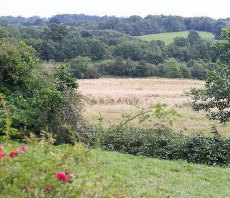
A tour of Hastings battlefield and Battle Abbey
The battlefield was located between two hills, Caldbec Hill to the north and Telham Hill which lies to the south. The terrain was at that time heavily wooded, with a nearby area of marsh. The Anglo-Saxon Chronicle refers to Hastings as the battle 'at the hoary apple tree'. Within the space of forty years, the battle came to be known as "Senlac", a Norman-French derivation of the Anglo-Saxon "Sandlacu", meaning "sandy water". The battle had already come to be known as "Bellum Hasestingas" or the Battle of Hastings by 1087, during the time of the compilation of the Domesday Book.

The Battle of Alnwick - 1093
In November 1093 Malcolm Canmore, King of Scots and his son Edward led an assault into Northumbria, where they besieged Alnwick Castle, one of the strongest castles in Northumbria, Malcolm camped his main army north of the River Aln on the slopes of the hill overlooking the valley. Robert de Mowbray, Earl of Northumbria, arrived at Alnwick on St Brice’s Day, 13 November, taking the Scots army totally by surprise, the English force attacked them before the ramparts of Alnwick, throwing the unprepared Scots into complete confusion. In the final skirmish, King Malcolm's vanguard was smashed, Malcolm Canmore was killed in the fighting and his son Edward was mortally wounded.
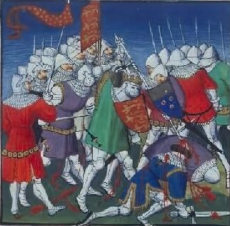
The Battle of Tinchebray - 1100
The battle of Tinchebrai was fought on the 28th September 1106 near the town of Tinchebrai on the border of the county of Mortain, in the southwest of Normandy, between the armies of King Henry I of England and his brother, William the Conqueror's eldest son, Robert Curthose, Duke of Normandy. Robert Curthose' army began battle by attacking the invading English. William of Mortain led the charge and succeeeded in driving back Henry's lines but was surprised by the appearance of reserves from Maine and Brittany, the battle lasted less than an hour. The Saxons among Henry's army felt that fifty years later, the humiliation of Hastings had been truly avenged.
The Anarchy

The Battle of the Standard - 1138
During the civil war known as the Anarchy, the cousins Stephen and Matilda struggled to control the English throne. David I, King of Scots supported the claims of his niece Matilda, the daughter of his sister, Edith of Scotland, who had married Henry I in 1100. With his son Henry, Earl of Huntingdon. The resulting conflict reulted in victory for King Stephen/ Within a space of three hours, much of the Scottish host had begun to flee, apart from small bodies of knights and men-at-arms who were gathered around King David and his son Henry. David and his son then withdrew in relatively good order. While the English did not attempt a major pursuit, numerous Scots that were fleeing from the area of the battle were killed.
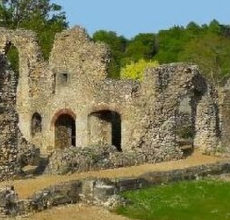
The Rout of Winchester - 1141
During the Civil War known as 'the Anarchy, King Stephen had usurped the throne of his cousin the Empress Matilda. The army of imprisoned King Stephen, which was led by his wife, Matilda of Boulogne, Bishop Henry of Blois and William of Ypres, faced Empress' army, commanded by her half-brother Earl Robert of Gloucester. After Matilda's army besieged a castle on the edge of Winchester, they arrived and blockaded the Angevin army within the city. Cut off from supplies, the Angevin army gave up the siege, then was crushed as it began to retreat. Robert of Gloucester was captured and was subsequently exchanged for Stephen, who was then returned to the throne.
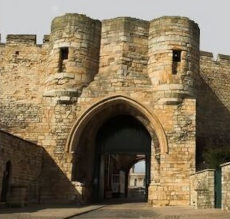
The Battle of Lincoln - 1141
The contest between King Stephen and his cousin the Empress Matilda, daughter of King Henry I, for the crown of England went on for nineteen long years, known as 'the Anarchy', with first one side then the other gaining the upper hand. After fierce hand-to-hand fighting in the streets of Linncoln, Stephen's forces were eventually defeated and the King was captured and handed over to the Empress Matilda.
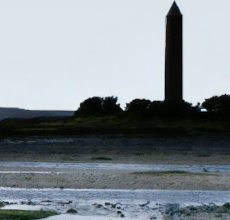
The Battle of Largs - 1263
Alexander III of Scotland made agressive attempts to recover the Hebridean Islands, known as Innse Gall, and Argyll from the grip of the Norwegians, launching raids against them including a raid on the Isle of Skye in 1262. The Western Isles had for centuries been disputed between the Scots and the Norse. King Haakon IV of Norway mounted a pre-emptive attack to secure Norse control of the area. The Norwegians were routed and the fleeing Norse were then pursued, great slaughter ensued, with most fleeing to their boats.
Scottish Wars of Independence
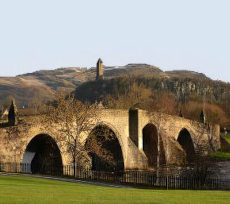
The Battle of Stirling Bridge - 1297
The Battle of Stirling Bridge was fought on 11 September 1297, between the forces of William Wallace and Andrew Moray and an army composed of English, Welsh and Scots knights, bowmen and foot soldiers under the command of John de Warenne, 6th Earl of Surrey, and Hugh de Cressingham. Stirling Bridge was Wallace's greatest victory, which was gained despite the fact that the Scots were less well equiped and far outnumbered, forces lead by Wallace and Andrew Moray used clever military tactics to rout the English.

The Battle of Falkirk - 1298
The Battle of Falkirk was fought on 22 July 1298, between the forces of the Scottish patriot, William Wallace and those of King Edward I of England.Despite his victory in battle, Edward's lack of supplies rendered him incapable of following up the victory. Tired and hungry, the English army withdrew to Carlisle. After experiencing the bitter taste of defeat at Falkirk, William Wallace resigned as Guardian of Scotland.
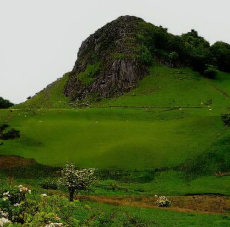
The Battle of Loudon Hill - 1307
In 1307, Robert the Bruce, following a time spent in hiding following the Battle of Methven, had begun a campaign to wrest his kingdom back from Edward I of England. English forces opposing him were under the command of Aymer de Valence, the 2nd Earl of Pembroke. Bruce's men dug a series of trenches, forcing the English towards boggy ground around Loch Gait. This allowed the Scots to repulse the English army. The first attack broke, and the English fled the field.
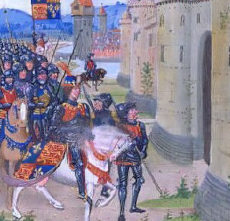
The Battle of Halidon Hill - 1333
The Battle of Halidon Hill was fought during the Second War of Scottish Independence. Scottish forces under Sir Archibald Douglas were heavily defeated by the English forces of King Edward III and Edward Balliol on unfavourable terrain while trying to relieve Berwick-upon-Tweed.
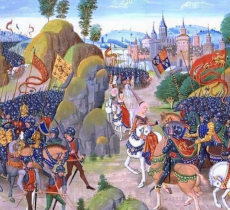
The Battle of Neville's Cross - 1346
A Scottish army under the command of David Bruce invaded England while King Edward III was absent campaigning in France. The English forces in the north were commanded by Ralph Neville, 2nd Lord of Raby, Henry Percy and William Zouche, Archbishop of York. David II led his army to the high ground at Neville's Cross, on moorland just to the west of Durham, to prepare for battle. The battle progressed badly for the Scots, their left division were seperated from the English by a steep ravine and while attempting to attack across this obstacle were under heavy fire from the English archers, the division began to disintegrate into confusion and retreat. The Scot's right division, however, caused the English to retreat, which then exposed their flank to the English reserves, and they then began to falter. As their position grew more dangerous, David II's nephew, Robert Stewart panicked and fled the battlefield, but David displayed himself a true son of Robert the Bruce, fighting on with valour, despite having two arrows in his body.
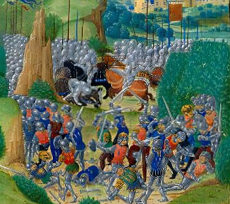
The Battle of Otterburn - 1388
The Battle of Otterburn took place on 5 August 1388, according to Scottish sources, which is contradicted the date of 19 August as recorded in English sources. The battle continued into the moonlit night, due to the darkness, Hotspur was unable to use his archers and the combatants were locked in grim hand-to-hand fighting. Douglas was wounded in the neck and slain on the field, his death went unnoticed until much later, Harry Hotspur and his brother Ralph were both captured, Hotspur being taken by Sir John Montgomery. Estimates number around 500 Scots were dead or wounded as well as 200 captured. English losses ammounted to between 1,000 and 1,500.
Hundred Years War
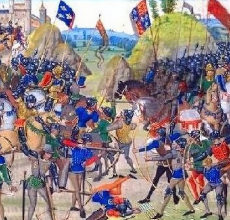
The Battle of Crécy - 1346
Fought on 26th August 1346 by the armies of King Edward III of England and King Philip VI of France, was a resounding victory for the English longbow men. Following a long, three hundred mile march from Cherbourg, with skirmishing along the route, the English invading army arrived at the Forest of Crécy, to face an overwhelmingly larger French and Genoese army. After resting overnight, the English occupied the high ground between the towns of Crécy and Wadicourt. The king himself occupied a windmill on a small hill that protected the rear, where he could direct the course of the battle.
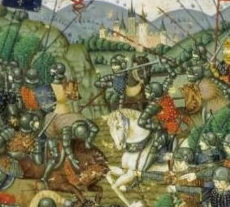
The Battle of Agincourt - 1415
Henry V revived his great- grandfather King Edward III's claim to the French throne and after negotiations with his French counterpart had broken down, led an English army into France in 1415, renewing what later came to be known as the Hundred Years War. On 25th of October, 1415, the feast day of Saints Crispin and Crispinian, Henry V' small, exhausted English army defeated the might of the French chivalry at Agincourt. The battle of Agincourt was one of the most resounding victories in the Hundred Years War.
Wars of the Roses
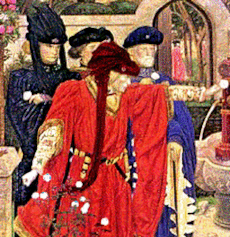
The Wars of the Roses
The Wars of the Roses were a series of dynastic wars fought between supporters of two rival branches of the House of Plantagenet, the houses of Lancaster, whose emblem was the red rose and the House of York whose badge was the white rose.
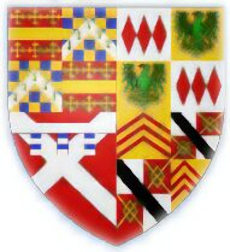
The First Battle of St. Albans - 1455
Fearing the he may be arrested for treason, the Duke of York secretly mustered troops in the north and began moving south towards London. he was joined on the route by his brother in law, Richard Neville, Earl of Salisbury and nephew Richard Neville, Earl of Warwick. The king's forces marched north to confront the rebels. Surprised by the speed of York's advance, on the morning of 22 May, Henry ordered his men to occupy the fortified town of St. Albans. The more neutral Duke of Buckingham was placed in charge of the royal army in place of the Duke of Somerset and Henry's royal standard was raised in the Market Square. A fierce battle ensued, as the market place and surrounding streets became crowded soldiers. Warwick quickly overcame the Lancastrian forces, who began to flee. His archers were ordered to fire at the men surrounding the king, killing several and wounding the king himself in the neck. Two rival peers were hacked to death in front of the king in Holywell Street and Henry VI himself was captured and was taken to a nearby cottage to have his wound dressed.
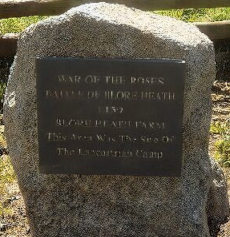
The Battle of Blore Heath - 1459
Following the Yorkist victory at First Battle of St Albans and the capture of the Lancastrian King Henry VI by his overmighty subject Richard, Duke of York in 1455, a time of uneasy peace and mutual distrust and suspicion gripped the Houses of York and Lancaster. A Yorkist force based at Middleham Castle under the command of Salisbury attempted to link up with the main Yorkist army at Ludlow. As the Earl of Salisbury led his army through the Midlands Queen Margaret ordered Lord Audley to intercept them, which he did at Blore Heath. The result was a Yorkist victory and Lord Audley was killed in the fierce hand to hand fighting.
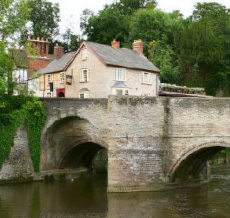
The Battle of Ludford Bridge - 1459
Henry VI's antagonistic queen, Margaret of Anjou raised support for her husband and the Yorkist Richard Earl of Salisbury, brother-in-law of the Duke of York, advanced from his base at Middleham Castle in Yorkshire to join with the main Yorkist army under York's eldest son, Edward Earl of March at Ludlow Castle in Shropshire, Salisbury's son, Richard Neville, Earl of Warwick, marched from London to Warwickshire with a further Yorkist force. Legend states that Queen Margaret of Anjou watched the battle from the nearby Mucklestone church tower, and fled when she realised her army had lost. The advantage gained by the Yorkists was short-lived as but three weeks later York deserted his army at Ludford Bridge and fled to Ireland. Salisbury and Warwick fled to Calais and the Yorkist army surrendered to the king.
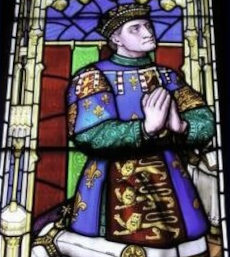
The Battle of Wakefield - 1460
The Battle of Wakefield was fought at Sandal Magna near Wakefield, in Yorkshire and was a decisive battle in the civil war known as the Wars of the Roses. A force led by nobles loyal to the Lancastrian King Henry VI faced the army of Richard, Duke of York, the rival Yorkist claimant to the throne, who met his death in the battle.
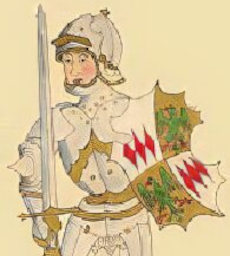
The Battle of Northampton - 1460
The Lancastrians were placed at a disadvantage when the driving rain that afternoon rendered the their cannon unable to fire. The Lancastrians were further hindered by treachery in their ranks, as Warwick approached the Lancastrian left flank, Lord Grey of Ruthin ordered his men to lay down their weapons and offer the Yorkists no resistance. They were therefore able to enter the camp beyond the ditch with ease. Lord Grey had previously sent a message to Edward, Earl of March promising to change sides if the Yorkists would aid him in his property dispute with Lord Fanhope. The battle was over in a mere thirty minutes. The Lancastrians were unable to manoeuvre inside the fortifications, and fled the field before the attacking Yorkists. Many were drowned in the rain-swollen River Nene.
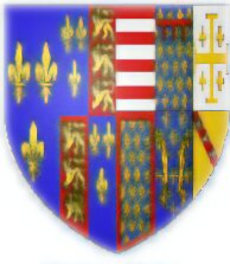
The Second Battle of St. Albans - 1461
A Yorkist army under the Earl of Warwick attempted to bar the road to London. The rival Lancastrian army used a wide outflanking manoeuvre to take Warwick by surprise, cut him off from London, and drive his army from the field. The Lancastrians also released King Henry VI, who had been Warwick's prisoner, from his captivity.
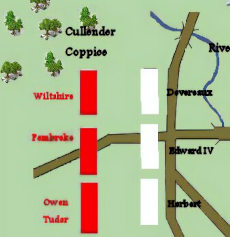
The Battle of Mortimers Cross - 1461
The Battle of Mortimer's Cross was fought by the River Lugg near Wigmore in Herefordshire, at a site not far from the border with Wales. The young Edward, Earl of March, (later Edward IV) head of the Yorkist faction, faced an army commanded by lords loyal to Lancastrian King Henry VI. The Lancastrians opened the battle with the Earl of Wiltshire's division attacking Edward's right-wing and forcing them to retreat across the road. Jasper Tudor attacked the Yorkist centre but was held back, Owen Tudor attempted to surround Edward's left-wing but was defeated which led to the rout of his forces. Jasper Tudor's 's division was then also smashed leading the Lancastrian soldiers to flee in disarray and panic, around 4,000 Lancastrians were slain, although Pembroke and Wiltshire managed to escape the field they were pursued by the Yorkists as far as the town of Hereford, around seventeen miles away, where Owen Tudor himself was taken, prisoner.
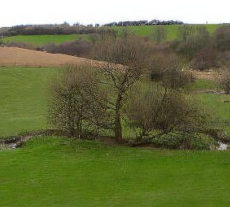
The Battle of Towton - 1461
The Battle of Towton, a bitter blood bath and one of the largest and bloodiest battles ever fought on British soil, took place in a snowstorm on a bleak plateau near the village of Towton in Yorkshire. The result was total victory for the Yorkists while the Lancastrians suffered heavy losses, it was said that all the way from Towton to Tadcaster the fields were full of bodies.
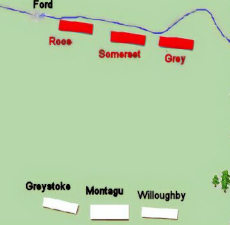
The Battle of Hexham - 1464
The Battle of Hexham, 15 May 1464, marked the end of significant Lancastrian resistance in the north of England during the early part of the reign of Edward IV. The battle was fought near the town of Hexham in Northumberland. John Neville, later to be Marquess of Montagu, led a Yorkist force which routed the rebel Lancastrians. Most of the rebel leaders were captured and executed, including Henry Beaufort, Duke of Somerset, and Lord Hungerford.
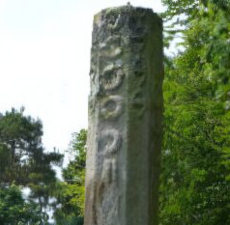
The Battle of Hedgeley Moor - 1464
The ever determined Queen Margaret of Anjou, who had retreated to Scotland with her young son after her forces suffered defeat at Towton, where she found refuge at the court of King James III. Margaret gathered her forces and launched an invasion of England in the early part of 1464. The Lancastrian queen captured several northern castles, and was joined by Somerset and the Percy family. The series of events of the battle are fairly unclear. Battle probably commenced with the usual exchange of arrows between the two sides. Montagu then advanced across the 1,500 yards This was followed by the whole Lancastrian force breaking as the Yorkists clashed with them, all but a few of the remaining Lancastrians fled the field in panic. Somerset succeeded in rallying many of the Lancastrians and retreated in reasonably good order into Tynedale.of moorland, but was forced to halt and readjust his lines when the Lancastrian left flank, under the command of Lords Roos and Hungerford faltered without even striking a blow, broke and fled.

The Battle of Edgecote Moor - 1469
Richard Neville, Earl of Warwick became alienated from his cousin Edward IV after the latter's marriage to the avaricious Elizabeth Woodville. Battle was fought between a Royal army, commanded by the earls of Pembroke and Devon, and a rebel force led by supporters of the Earl of Warwick. On the arrival of rebel reinforcements Pembroke's men broke and fled. In the aftermath of the battle, King Edward was taken into custody and held in Middleham Castle. His father-in-law Earl Rivers and was executed.
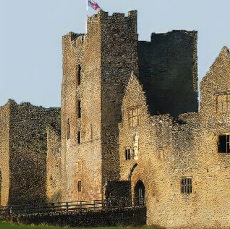
The Battle of Losecoat Field - 1470
The battle secured the defeat of the poorly organised Welles Uprising against King Edward IV, but ultimately led to the defection of Richard Neville, 16th Earl of Warwick and the king's brother George, Duke of Clarence to the Lancastrian cause after they were forced to flee the country having been implicated in the rebellion.
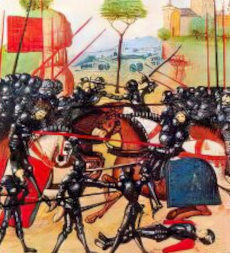
The Battle of Barnet - 1471
The Battle of Barnet was a decisive confrontation in the Wars of the Roses, between the rival Houses of Lancaster and York, along with the subsequent Battle of Tewkesbury, it secured the throne for the Yorkist King Edward IV. According to the official version of the battle, Warwick the Kingmaker, who had defected to the Lancastrians, was killed fleeing the field in attempt to reach his horse. Probably the most likely method of his despatch was a sword thrust into his throat, after forcing open his visor.
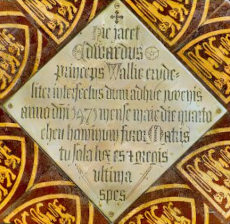
The Battle of Tewkesbury - 1471
The Battle of Tewkesbury resulted in crushing the Lancastrian cause and securing the throne for the Yorkist King Edward IV. Queen Margaret's son, the eighteen year old Edward, Prince of Wales, the last legitimate descendant of the House of Lancaster, was killed either in battle or during its aftermath.

The Battle of Bosworth - 1485
Richard III, the third Yorkist king's claim to the throne was challenged by Henry Tudor, Earl of Richmond, a Lancastrian claimant through his mother Margaret Beaufort. Their armies clashed at Bosworth Field, Leicestershire. Richard III was killed in the fighting and the crown of England was placed on the head of Henry Tudor, the founder of the Tudor dynasty.
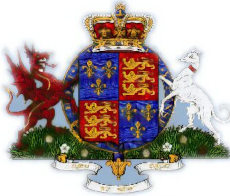
The Battle of Stoke Field - 1487
The Battle of Stoke Field was the last battle of the dynastic conflict known as the Wars of the Roses. King Henry VII's forward troops, commanded by the Earl of Oxford, an able and experienced general, encountered the Yorkist army who were depoyed in an advantageous position on the top of Rampire Hill where the River Trent forms a loop at the village of East Stoke as it flows between Nottingham and Newark, the ford at Fiskerton lying some 4 miles to the south of Newark. The battle raged fiercely for over three hours, although the Yorkist claimant, de la Pole's German mercenaries were equipped with the latest handguns, the large numbers of archers in the Lancastrian army proved to be decisive. The longbowmen were able to shoot volley after volley into the Yorkist position. The Irish troop's lack of sufficient body armour resulted in their being cut down in large numbers by the Lancastrian arrows. The Yorkists finally broke and fled towards the River Trent down a ravine, known locally as the Bloody Gutter, in which they were killed in large numbers.
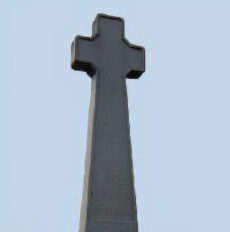
The Battle of Flodden - 1513
The Battle of Flodden was one of the greatest defeats ever to be suffered by the Scots, was fought in Northumberland on 9 September 1513. James IV, King of Scots declared war on on the English King Henry VIII in suppport of the historic Auld Alliance with France. Hoping to take advantage of his brother-in-law's absence while campaigning in France, James proceeded to the border with a huge army of Scots. The Earl of Surrey, son and heir of John Howard, 1st Duke of Norfolk, was ordered north to meet him by the English Regent, Henry VIII's first wife, Catherine of Aragon. In the aftermath of the battle. the flower of Scotland's chivalry lay dead on the field, including King James IV himself fought valorously in the thick of the battle, with a courage even his opponents could but admire.
Civil wars
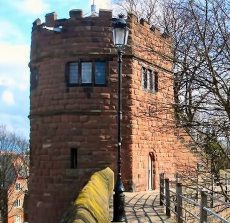
Battles of the Civil War
The Civil War (1642–1651) resulted in a series of battles between Parliamentarians and Royalists. Controlling the powers of the king issues of religious freedom were primary factors. The wars also involved the Scottish Covenanters and Irish Confederates. The war resulted in the execution of Charles I by parliament, whereafter England became a republic, headed by Oliver Cromwell as Lord Protector. They ended with Parliamentarian victory over Charles II and a Scottish army at the Battle of Worcester in 1651.
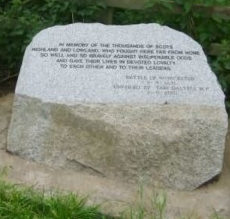
The Battle of Worcester - 1651
Following the execution of King Charles I, in attempt to regain the lost throne of the Stuarts, Charles II sailed for Scotland to ally himself with the Covenanters against their mutual enemy, Oliver Cromwell. Cromwell's Parliamentarian New Model Army, 28,000 strong, defeated King Charles II's 16,000 Royalists, of whom the vast majority were Scottish.

The Massacre of Glencoe - 1692
The unruly Catholic Highland clans of Scotland, having taken part in the Jacobite Uprising to restore James II to the throne, were perceived as a threat to the government of King William III. Consequently, the Highland chiefs were required to take the Oath of Allegiance to the king before a magistrate by 1st January 1692. They were threatened with reprisals as a consequence of not signing the oath. Macdonald 0f Glencoe took the oath, but the journey to Inveraray took three days due to the winter weather and the fact that he was detained at Barcaldine Castle, therefore, arrived after the allotted deadline. Campbell of Glenlyon, with over a hundred armed men was billeted at Glencoe and had enjoyed the McDonald's hospitality, as was the custom in the Highlands, for a number of days, when Captain Drummond arrived on 12th February with orders from his commander, Major Duncanson 'to fall upon the rebels, the McDonalds of Glencoe, and put all to the sword'. Glenlyon's soldiers brutally slaughtered men, women and children, no mercy was shown.

The Battle of Culloden - 1746
The Jacobite army of Charles Edward Stuart or 'Bonnie Prince Charlie' was soundly defeated by a Hanoverian army led by William Duke of Cumberland, son of George II, The defeat marked the end of the Jacobite Rising of 1745-46.
